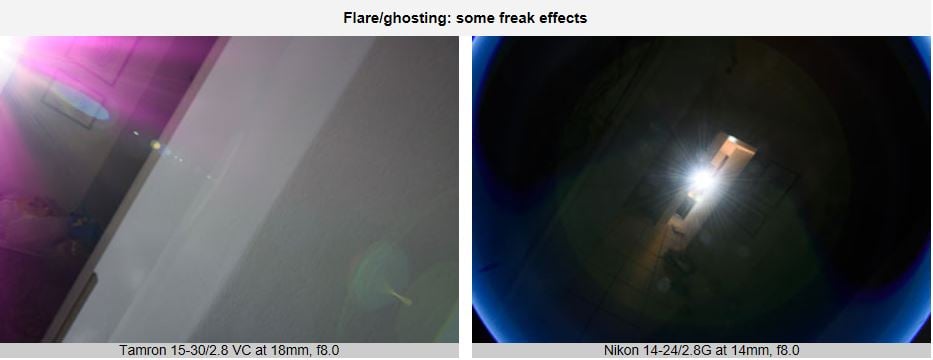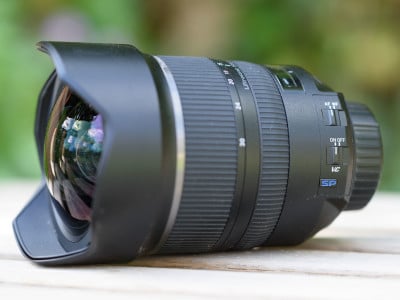Tamron SP 15-30mm f2.8 VC review
-
-
Written by Thomas
Quality
Sharpness and contrast
Let’s have a look at the theoretical performance of this lens at the wide and the long end first:
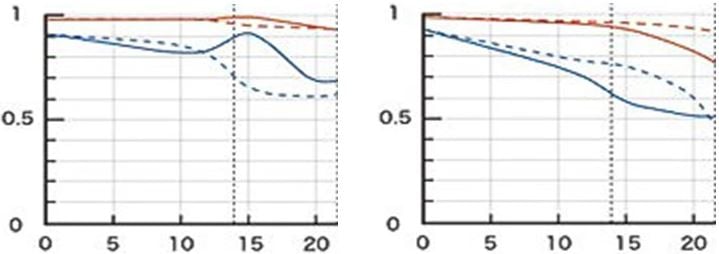
Above: Tamron SP 15-30/2.8 Di VC USD MTF; left at 15mm, f2.8; right at 30mm, f2.8
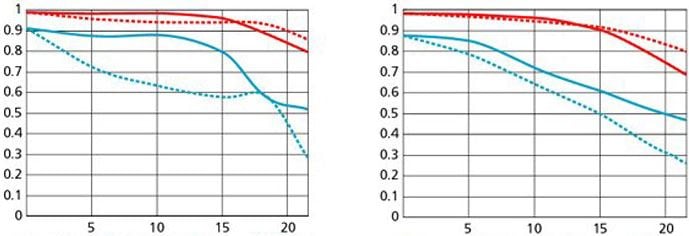
Above: Nikon AF-S 14-24/2.8G MTF; left at 14mm, f2.8; right at 24mm, f2.8
These MTF charts show the lens-performance at the largest aperture of f2.8. Higher values are better and the closer the dotted and the continuous lines of each color are together the less astigmatism (= resolution depends on the orientation of the test-pattern) the lens has. The x-axis displays the distance from the optical axis (=center of the sensor) in mm. I’ll show you the real-life performance at 4 mm (center), 13 mm (DX/APS-C-corner), and 20 mm (FX/FF-corner) on a 36MP D810.
From the charts the new Tamron should show very high overall contrast across the FX/full-frame sensor. Sharpness (contrast at fine structures) also looks pretty good in the DX/APS-C image circle but beyond that some astigmatism occurs. Compared to Nikon’s 14-24/2.8G it looks a bit better at almost any point on the sensor both at the short and the long end of focal lengths. At 30 mm resolution of fine details drops gracefully with little sign of astigmatism until beyond the DX/APS-C image circle. But let’s see how this theoretical performance translates into real life results in the sharpness test based on Siemens-stars.
What follows are near-center results (first column) followed by DX/APS-C-corner results and FX/FF-corner results on a D810. Processing was done in Lightroom 5.7 from RAW at camera standard settings. Noise-reduction is set to 0, sharpening to 35/0.5/36/10, with no extra tone, color, or saturation-adjustment. White-balance was adjusted to a neutral white and I did some exposure compensation to make the brightness match. CA-removal is ON.
The following are all 100% crops!
Here are the results at 15mm:
Tamron SP 15-30/2.8 VC on Nikon D810; 100% crop from center, APS-C/DX-corner, FF/FX-corner

Above: 15mm, f2.8

Above: 15mm, f4.0

Above: 15mm, f5.6

Above: 15mm, f8.0

Above: 15mm, f11
These 100% crops directly from a 36MP D810 sensor shows a very good performance right across the frame even wide open. Stop down to f4 and sharpness and contrast are excellent within the DX/APS-C image-circle. Only the barrel distortions are a bit high. Diffraction is setting in slightly at f8. There’s very little field curvature: both the FX-crops and the center-crops are actually from the same shots. Only the DX-crops are from different shots with a little optimized focus.
Following is a comparison with the Nikon 14-24/2.8G shot at 15mm f2.8:

Above: Tamron SP 15-30/2.8 VC at 15mm, f2.8

Above: Nikon 14-24/2.8G at 15mm, f2.8
In the center the Nikon is a bit softer than the Tamron, the DX-corner is on a par, and in the FX-corner the Tamron again has a slight lead. It’s also obvious that the Tamron produces less distortions in the DX-corner and FX-corner than the Nikon.
Similar story at 18mm: Very good results wide open this time with only little distortions. And at f5.6 even the FX-corner becomes flawless. Again very little field curvature.
Tamron SP 15-30/2.8 VC on Nikon D810; 100% crop from center, APS-C/DX-corner, FF/FX-corner

Above: 18mm, f2.8

Above: 18mm, f4.0

Above: 18mm, f5.6

Above: 18mm, f8.0

Above: 18mm, f11
Compared to the Nikon 14-24/2.8G shot at 18mm f2.8 on a D810, the results from the Tamron again are a bit better across the sensor and show less distortion:

Above: Tamron SP 15-30/2.8 VC at 18mm, f2.8

Above: Nikon 14-24/2.8G at 18mm, f2.8
At 24mm the DX-corner and FX-corner become a little softer wide open with some residual spherical aberrations reducing the contrast of thin lines in the FX-corner. You need to stop down to f8 to get rid of this effect. Distortions are now turning into pin-cushion form. Again field-curvature is very low:
Tamron SP 15-30/2.8 VC on Nikon D810; 100% crop from center, APS-C/DX-corner, FF/FX-corner

Above: 24mm, f2.8

Above: 24mm, f4.0

Above: 24mm, f5.6

Above: 24mm, f8.0

Above: 24mm, f11
This is the last focal length to compare the Tamron to Nikon’s 14-24/2.8G. Both lenses show a comparable performance in the DX/APS-C image-circle with a slight lead for the Tamron. In the FX-corner the Nikkor is clearly weaker due to some coma. Only when you stop it down to f5.6 does it catch up with the Tamron at f2.8. Regarding distortions the Nikon has the clear lead at 24mm.

Above: Tamron SP 15-30/2.8 VC at 24mm, f2.8

Above: Nikon 14-24/2.8G at 24mm, f2.8
30mm is the weakest length of the Tamron: Even only 4mm off center residual spherical aberrations reduce the contrast of fine structures a bit. But stopping down to f4 solves this problem and produces very crisp results in the inner image-circle and also lifts the DX-corners to a good performance. But the FX-corner stays pretty soft until f8. And the pin-cushion distortion becomes even more visible:
Tamron SP 15-30/2.8 VC on Nikon D810; 100% crop from center, APS-C/DX-corner, FF/FX-corner

Above: 30mm, f2.8

Above: 30mm, f4.0

Above: 30mm, f5.6

Above: 30mm, f8.0

Above: 30mm, f11
In these tests at close distances the Tamron outperformed the Nikon 14-24/2.8G at all focal lengths, which is quite a feat! Let’s see whether this carries over to my other tests.
Performance at long distances
The Siemens-star test-targets are shot at a distance of 40x focal length (i.e. at 1m for 25mm f.l.). But performance of lenses also depends on the shooting distance. Therefore I do another series of test-shots of a landscape dubbed the “Unremarkables” where you can measure distances in km, not meter. Processing was done in Lightroom 5.7 from RAW at Adobe Standard settings. Noise-reduction is set to 0, sharpening to 35/0.5/36/10, with no extra tone or saturation-adjustment. Only white-balance is adjusted to compensate a bit for the blueish light and make these shots comparable to others taken at the same time. There’s no tinkering with vignette-control so you see it here as it is produced by the lens. Focus was acquired at the largest aperture manually and not changed for other apertures.
You can click on each image to access the large original. Please respect our copyright and only use those images for personal use.
The main image shows the complete scene at the largest aperture to give you an impression of the angle of view and to judge vignetting. This is followed by one row of 100% crops at different apertures each from near the middle, the DX/APS-C-corner, and the FX/FF-corner.
Let’s start with 15mm focal length:
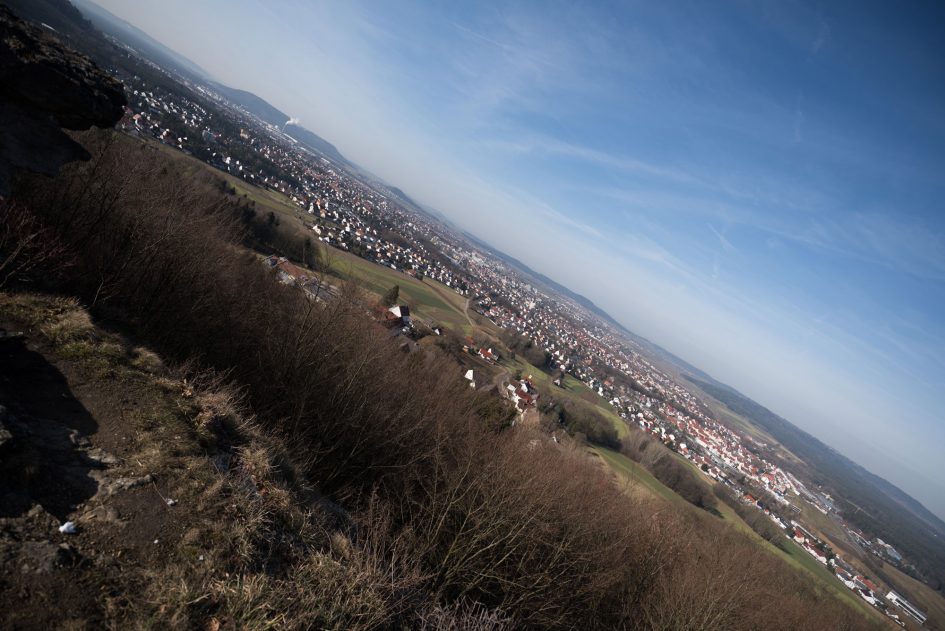
Above: Tamron 15-30/2.8 VC on a D810 at 15mm, f2.8; also available at f4.0, f5.6, f8.0, f11, f16
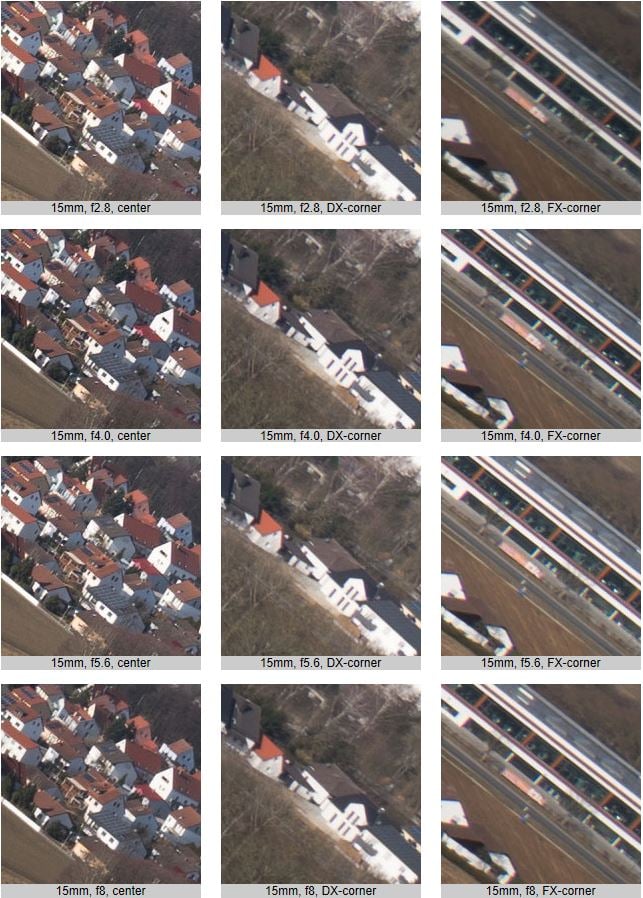
Surprisingly vignetting is not too strong at 15mm. Performance wide open is excellent in the center and deteriorates only slightly in the corners. Stopping down to f4 delivers a very good performance across the sensor.
Following is a comparison with the Nikon AF-S 14-24/2.8G at 15mm f2.8 shot only a few minutes apart. Both lenses produce almost identical results:
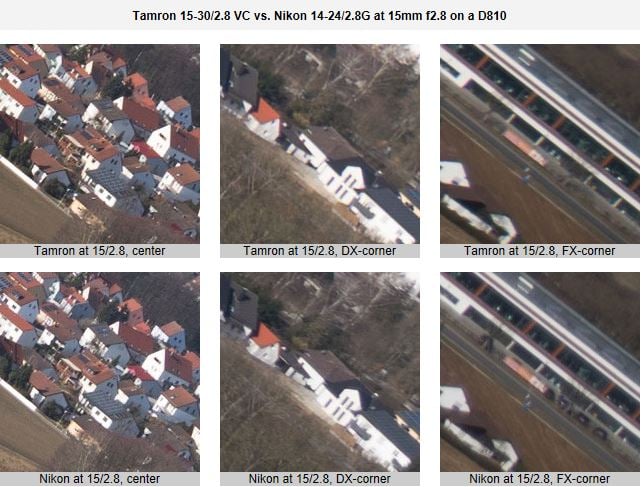
The shot of the Nikon at 15mm above is available at f2.8, f4.0, f5.6, and f8.0.
At 18mm the lens shows similar performance:
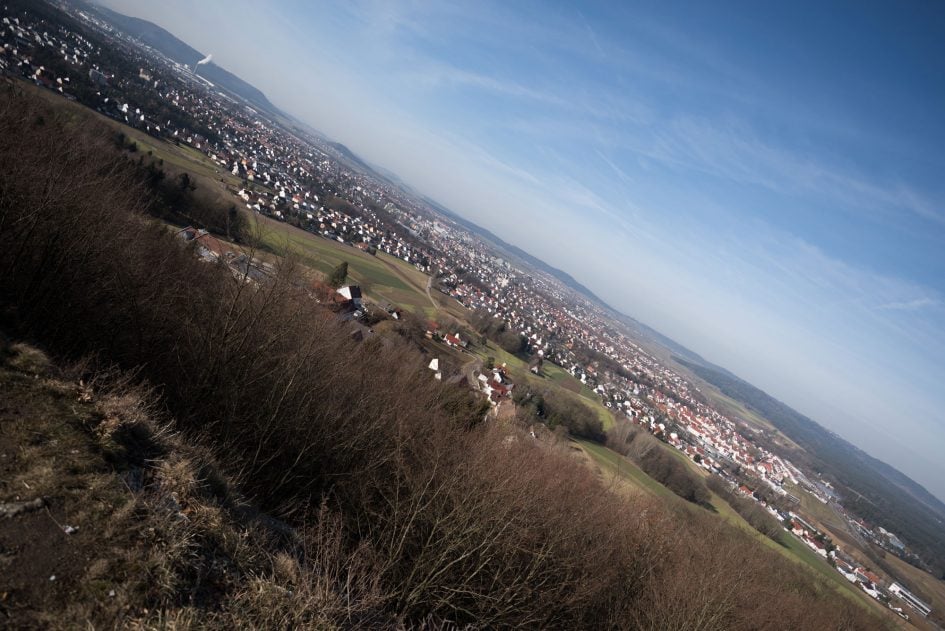
Above: Tamron 15-30/2.8 VC on a D810 at 18mm, f2.8; also available at f4.0, f5.6, f8.0, f11, f16
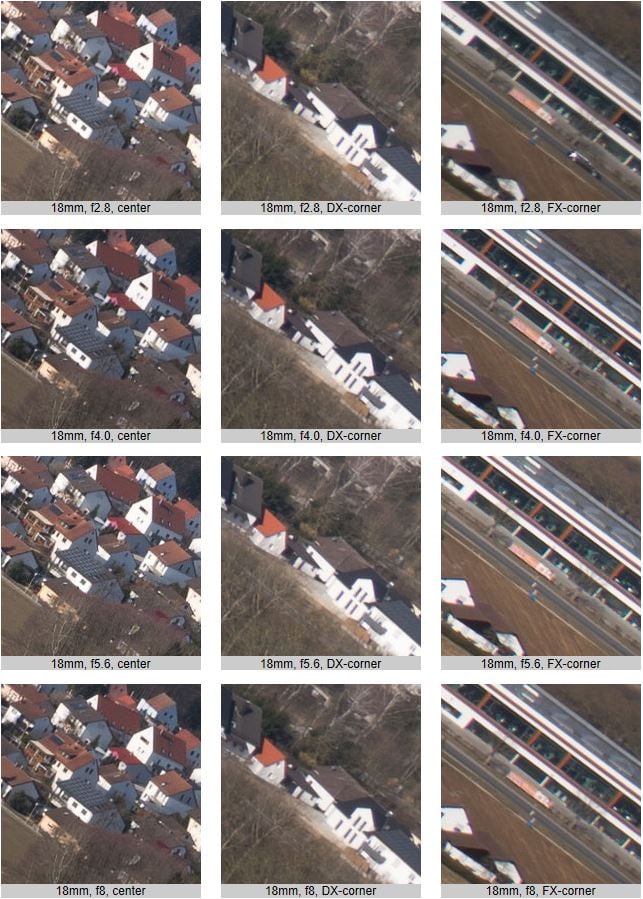
Compared to the Nikon the Tamron shows better clarity at 18mm and better sharpness in the FX-corner:
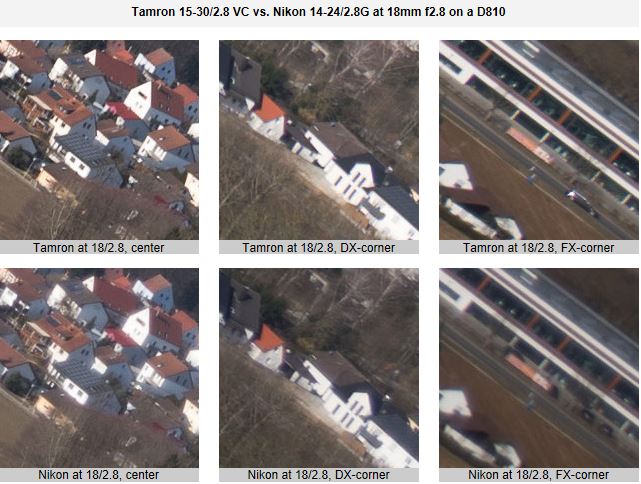
The shot of the Nikon at 18mm above is available at f2.8, f4.0, f5.6, and f8.0.
Pretty little vignetting at 24mm:
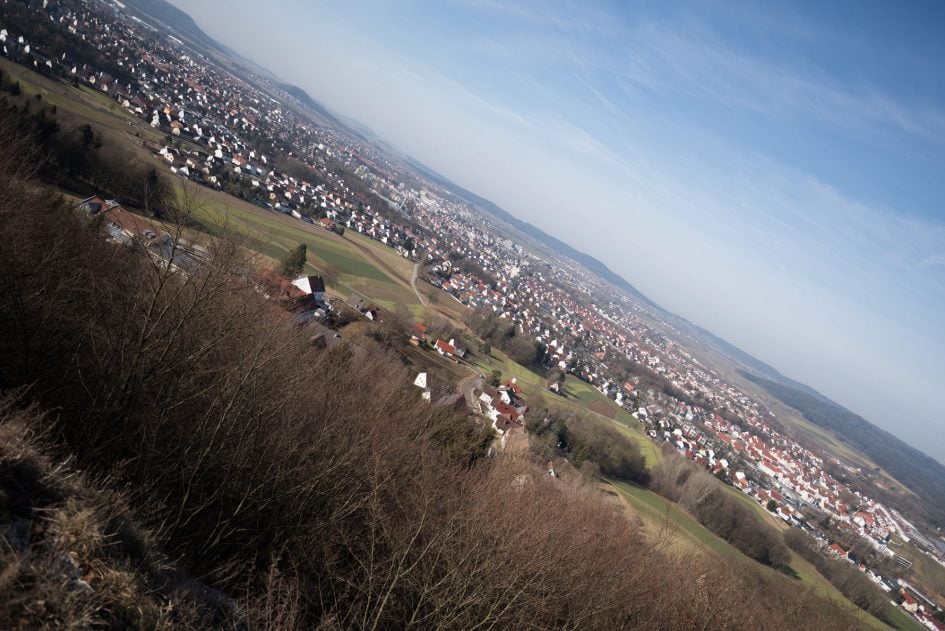
Above: Tamron 15-30/2.8 VC on a D810 at 24mm, f2.8; also available at f4.0, f5.6, f8.0, f11, f16
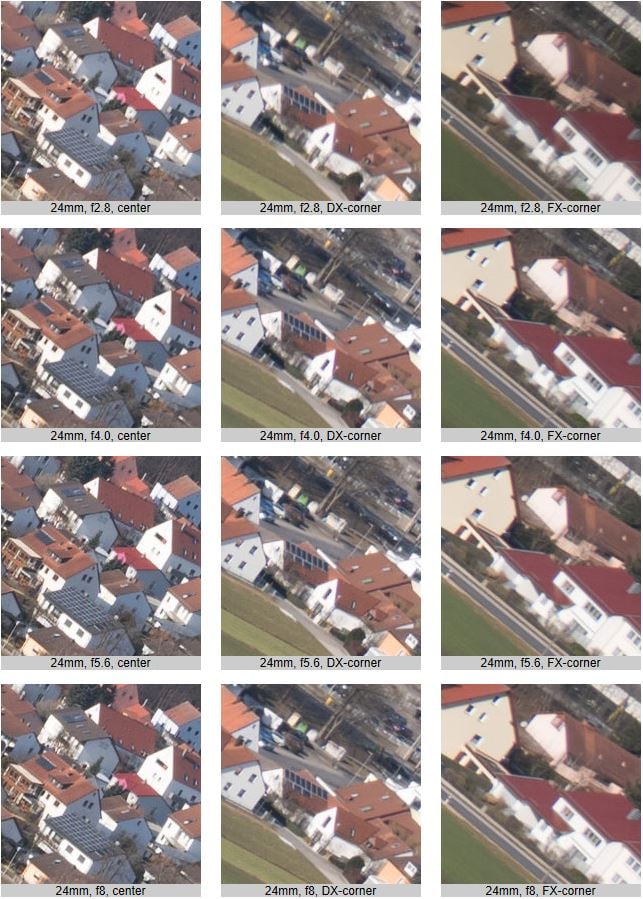
Great start at f2.8 with only a little softness especially along bright edges. This cleans up nicely at f4.
24mm is definitely the weak side of the Nikon AF-S 14-24/2.8G. As you can see in the comparison with the Tamron below it can hold up quite nicely in the center, but both the DX-corner and the FX-corner of the Nikon are much softer than from the Tamron. You need to stop the Nikon down to f5.6 to get comparable results.
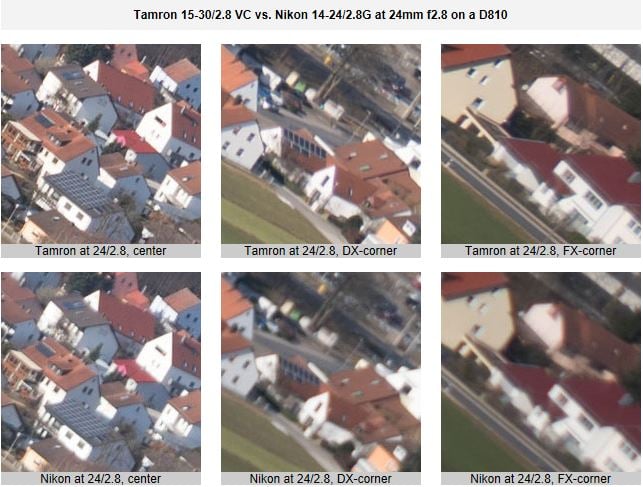
The shot of the Nikon at 24mm above is available at f2.8, f4.0, f5.6, and f8.0.
And lastly 30mm:
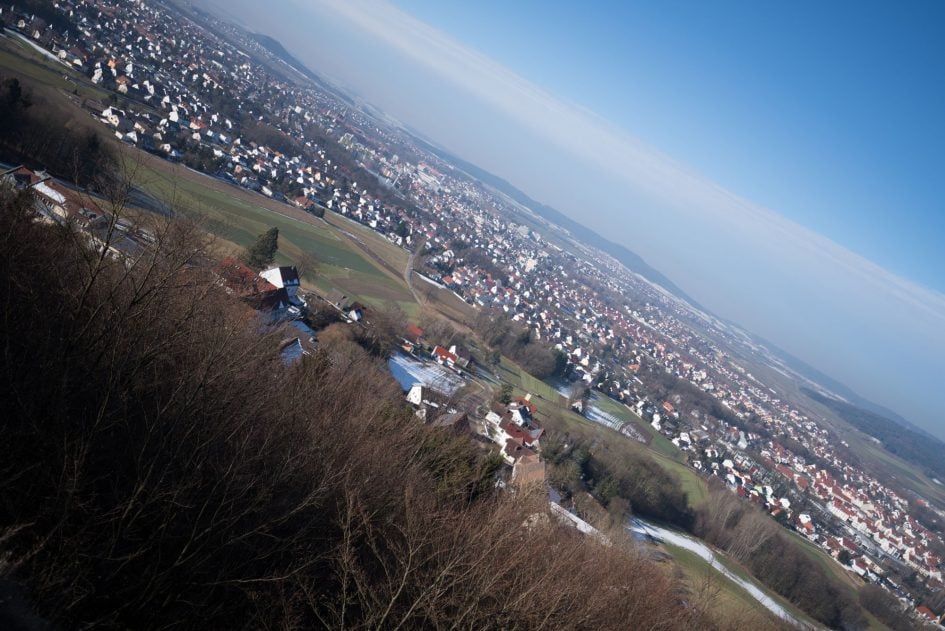
Above: Tamron 15-30/2.8 VC on a D810 at 30mm, f2.8; also available at f4.0, f5.6, f8.0, f11, f16
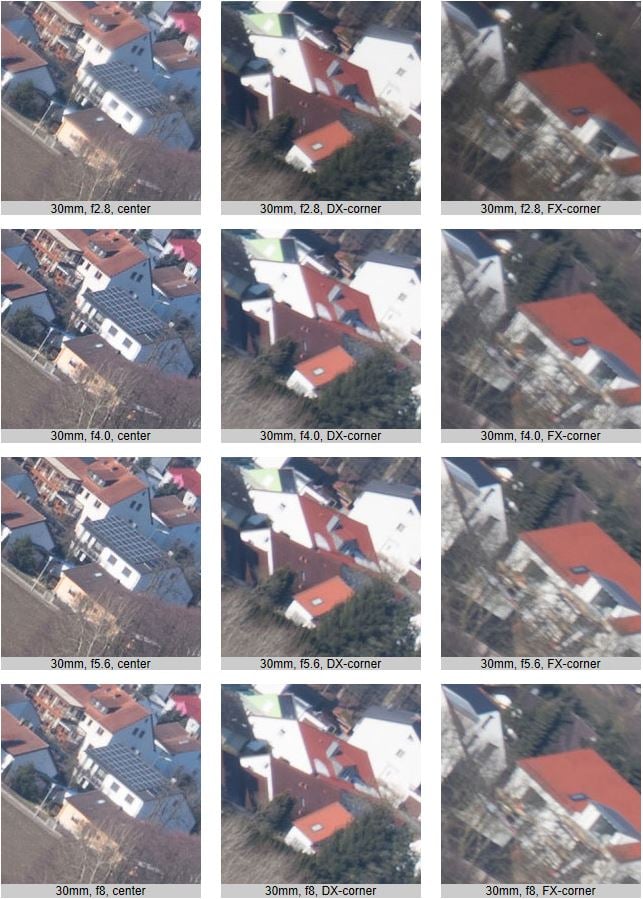
30mm is good in the center at f2.8 but even more mushy across the sensor than at 24mm. Stopping down to f4 cures most of that in the DX/APS-C image-circle but the FX/FF-corner stays a bit mushy even up to f8. This is certainly not the best focal length of the lens.
All-in-all the lens delivers very good results near and far even on the very critical 36MP sensor of a D810. Stopped down to f4 it is almost at its peak performance. Only at 30mm focal length does the Tamron show some limitation outside the center. At its widest end (15mm) it shows surprisingly little distortions and light fall-off.
Compared to the 14-24/2.8G from Nikon the new Tamron lens takes the lead in every comparison. Which is quite a feat considering that the Nikon was the benchmark of ultra wide angle full-frame zooms – up to now.
Rendering of point-light sources at night-shots
Night-shots pose a different challenge for lenses as the contrast is even higher than under bright sun and point-light sources can reveal some weaknesses such as coma, haloing and color-aberrations that do not show up as prominently in other test-shots. The following sets of 100% crops from two night-shot at 24mm and 15/14mm show the results from the new Tamron in the first row compared to the Nikon 14-24/2.8G in the second row at f/2.8 shot only a few minutes apart:
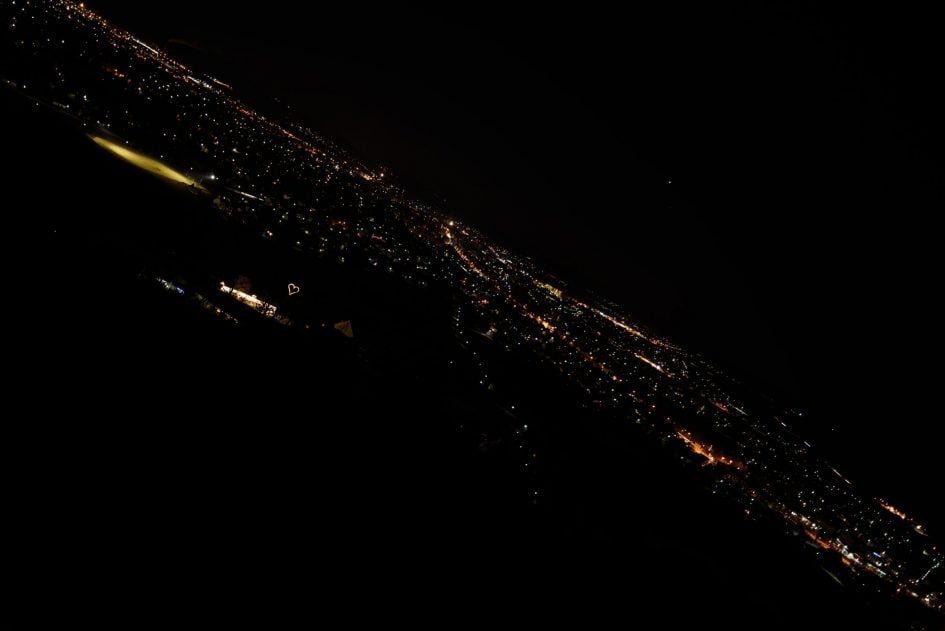
Above: Tamron 15-30/2.8 VC on a D810 at 24mm, f2.8; also available at f4.0, f5.6, and f8.0
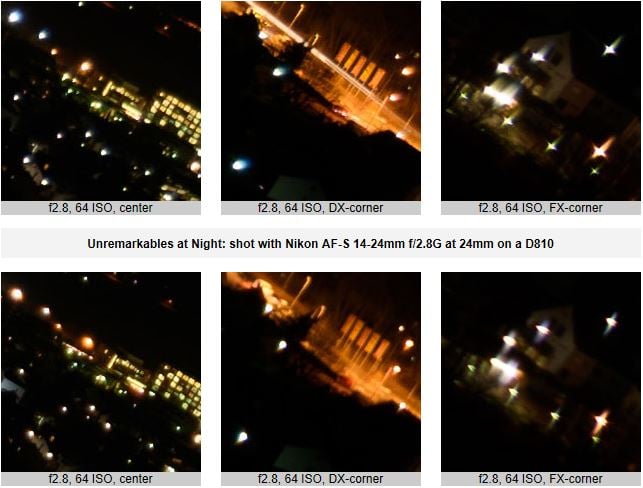
The Nikon images at 24mm are available at f2.8, f4.0, f5.6, and f8.0.
At 24mm focal length both lenses are not really too different in the FX-corner: Both show moderate coma. But in the DX-corner and the center you can see some differences. Point-light sources seem to halo a bit more and thus look a little less sharp on the Tamron. That doesn’t mean that the Tamron renders less sharp as you can see in the DX-corner. You can also see different color rendering of point-light sources (see the light in the upper left corner of the center crops) although both images were developed to the same white balance.
At 15mm on the Tamron and 14mm on the Nikon differences are smaller between both lenses. The amount of coma is pretty small on both which is quite a feat with such complex designs!
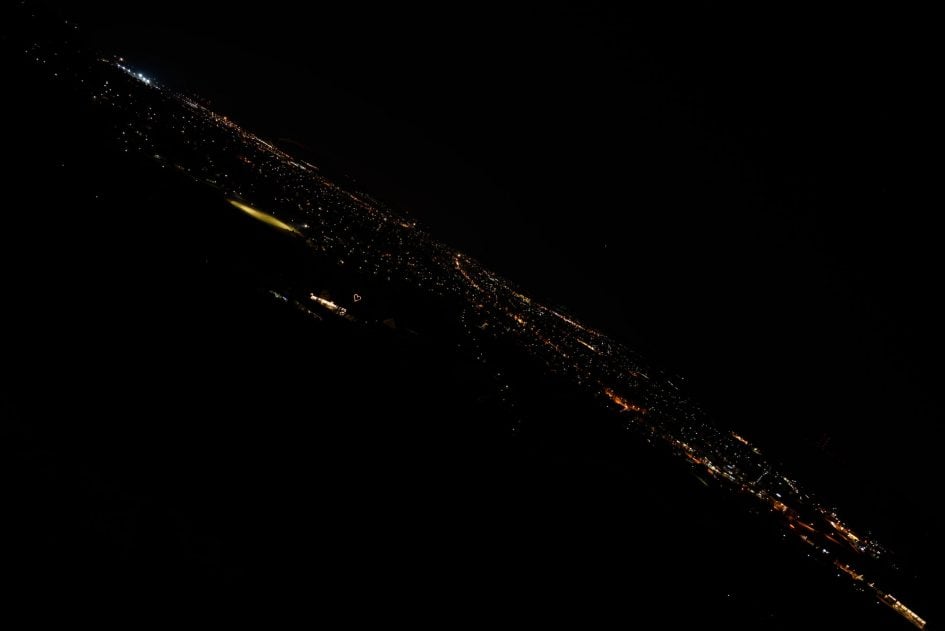
Above: Tamron 15-30/2.8 VC on a D810 at 15mm, f2.8; also available at f4.0, f5.6, and f8.0
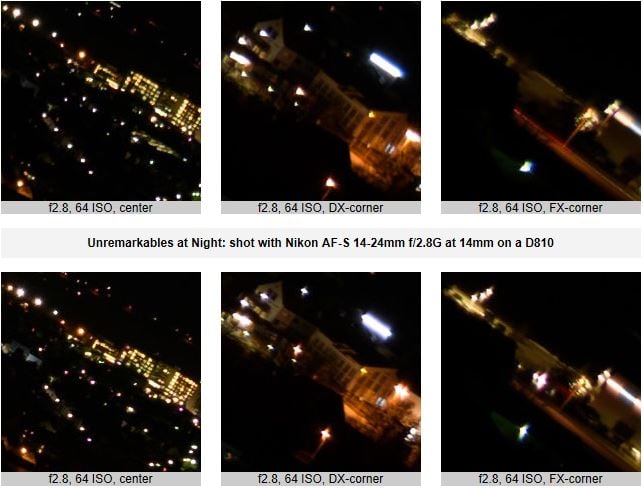
The Nikon images at 14mm are available at f2.8, f4.0, f5.6, and f8.0.
Rendering of out-of-focus point-light sources
This test is for the rendering of point-light sources in an out-of-focus background. The circle of confusion that is produced by this test is pretty indicative of Bokeh performance (in the background) and light fall-off. Ideally the out-of-focus image of the point-light is evenly lit and perfectly circular, with no “onion-rings”, and without coloration. Large aperture lenses normally produce an effect known as “cat’s eye” the further away from the optical axis the point-light is projected. This is due to optical vignetting in the lens barrel when light enters the lens from an angle. For an explanation of this effect have a look over at toothwalker.org. The following set of 50% crops from a night-shot show the results from the Tamron on the left and the Nikon on the right.
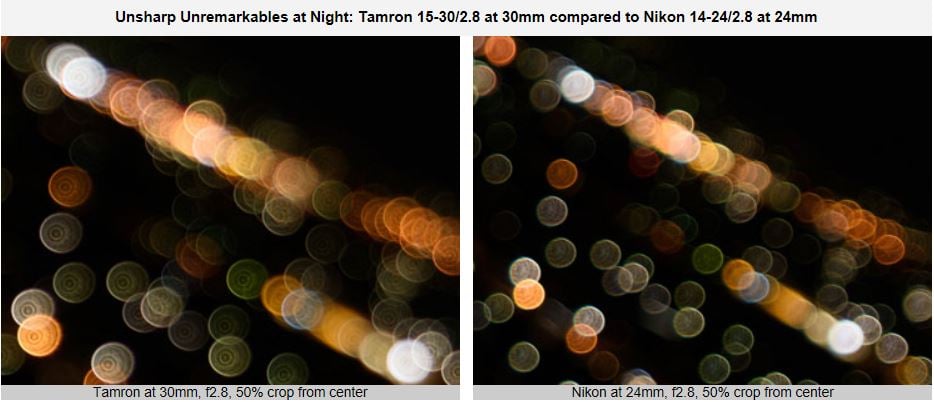
Original images available: Tamron at 30mm f2.8; Nikon at 24mm f2.8.
With both lenses the Bokeh balls are small and ugly with distinct outlining on both and onion rings that are more prominent on the Tamron. So you should avoid point-light sources and busy high-contrast objects in the background if you like it smooth. Although this can be quite a task when shooting with a wide-angle lens.
The Tamron has larger Bokeh balls by around 40% which is only partly explained by the 25% longer focal length (30mm vs. 24mm) in this comparison. Both lenses were pre-focused for this test so that an object in the plane of sharpest focus would have been reproduced at identical size.
Both lenses don’t show the classic cat’s eye effect although there is some compression of the Bokeh balls in the extreme corners. And there’s no clipping from the mirror-box of the camera. See the following crops from the FX-corner.
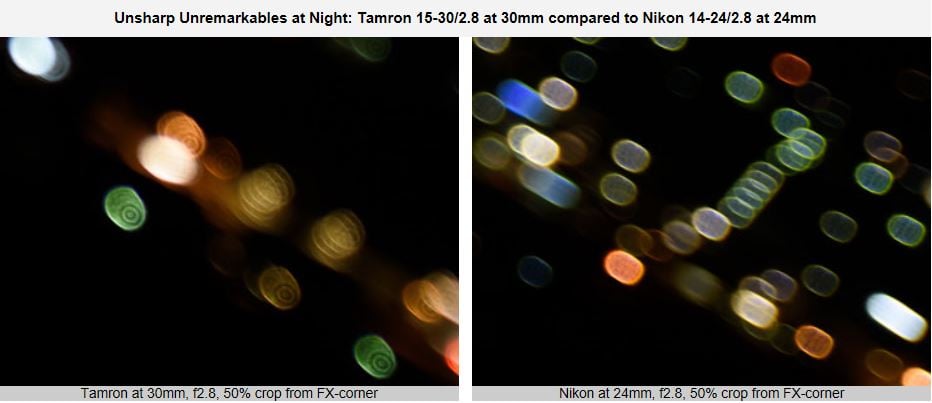
Original images available: Tamron at 30mm f2.8; Nikon at 24mm f2.8.
For real-live Bokeh performance head over to the next page.
Flare/ghosting
Catching a strong light-source like the sun shining directly into the lens can not always be avoided. Especially when the front element of the lens is protruding as prominently as with ultra wide-angle zooms. That could produce strange colorful ghosts-images or reduce contrast considerably through flare and glare.
The appearance of flare and ghosting depends on factors like the aperture and the angle of the light hitting the lens. So to judge the proclivity of the Tamron for these artifacts I went through 108 well calculated shots against a strong light source to provoke glare and ghosting. On 87 (=80%) of those shots you could clearly see flares or ghosts even on 400 pixel wide thumbnails. On 22 (=20%) of them the effect was pretty ugly. The Nikon had 57 from 72 shots with visible artifacts (=80%) and 20 (=28%) were pretty ugly. As the evaluation of the shots is no exact science I’d say both lenses are on a par in this category.
I’ve selected some of the most extreme examples from both lenses. The first comparison is with the light hitting the front element at a very flat angle with the light source far outside the frame. The effect on the Tamron is uglier than on the Nikon. In both cases it would have been very easy to shield the light with a hand but you simply run the risk of forgetting the danger when the light is so far to your side.
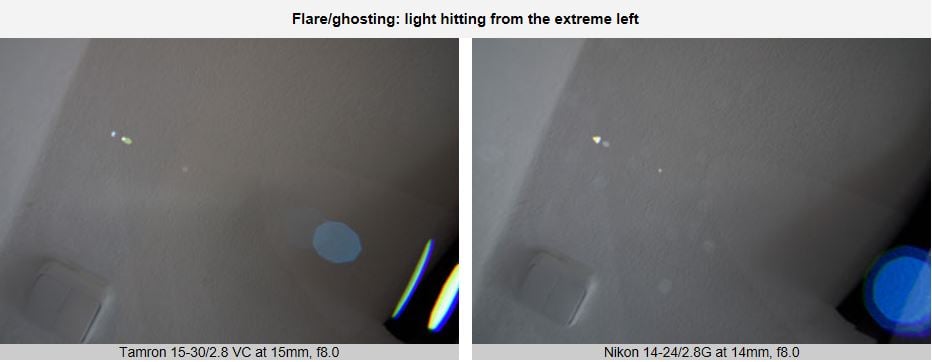
The second comparison is with the light just outside the FX-corner. It’s much harder in this case to shield the lens from the light without cropping into the frame. The Nikon shows the nastier effect here.
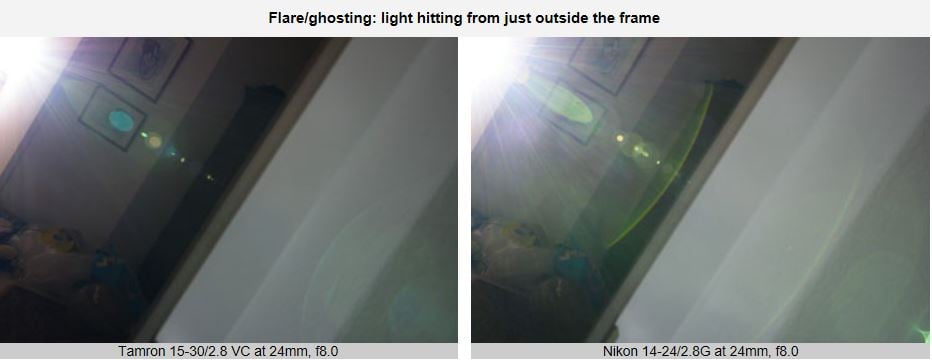
The last pair shows the most extreme effects that you can achieve with both lenses: The Tamron produces bright magenta streaks when the light hits from outside the frame but only at a very precise angle. Move the camera just a bit and it is gone. The Nikon produces a bright blue halo (at least from the LED headlamp I used for this test) when the light source is in the center of the image. Both effects are certainly not typical but they illustrate that you have to be quite careful when composing with these lenses.
